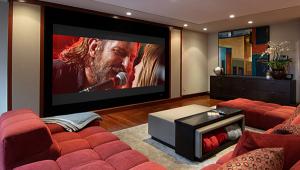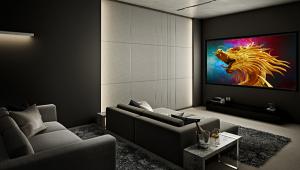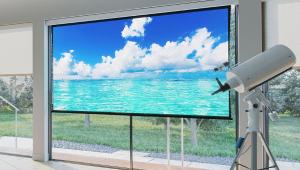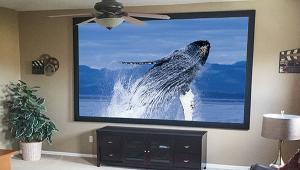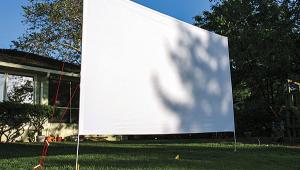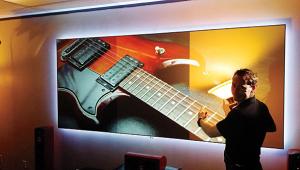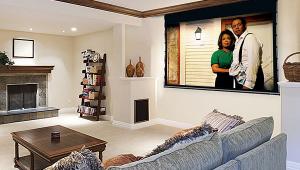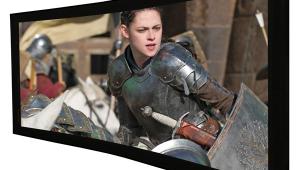Stewart Filmscreen Phantom HALR Ambient Light Rejecting Screen Review Page 2
Turning to Rocky Mountain Express, a treat that tells the story of the late-19th-century construction of the Canadian Pacific rail route, I sought out scenes I knew to be difficult. The black-and-white opening segment challenges many systems to correctly render the myriad creases, folds, and weighty, broad-shouldered aggregation of iron of a restored locomotive. Following that is a colorfully opulent, isolated journey sculpted through Canada’s western provinces. Here again, the Phantom revealed no weaknesses. My notes praised how, at even a radical angle (full disclosure: viewed from the kitchen!), colors steadfastly maintained intensity and saturation: “A lot like OLED!,” I jotted.
As ol’ Canadian Pacific 2816 slithered on the rails through wintry terrain, I did detect an anomaly I hadn’t previously seen with this disc. In a telescopic aerial shot with the locomotive in the foreground, gliding past an immense expanse of freshly minted snow, my attention locked onto a subtle, shaded hue within the white area on the screen, seemingly exacerbated by motion. In a manner similar to the way some backlit flat panels can appear splotchy with test patterns designed to check for white-field uniformity, a sensation of cloudiness was evident. Outside my Theater Two, night had fallen; inside, the room was dark.
So this issue was unrelated to light rejection. After I slid the Phantom to the side, refocused the Epson onto the Seymour, and selected its calibration memory. I replayed Rocky Mountain Express and was unable to locate this aberration. It seemed to have been screen dependent.
With the Phantom back in position, I quickly identified this smudginess using a scene of a bobcat seeking food in the midst of the punishing Rocky Mountain winter, probing desperately under the snow. When this type of uniformity issue appears on a flat-panel TV, some reviewers refer to it as “dirty window syndrome.” For round two, I moved the Phantom into Theater One, home of my FireHawk G3. This is a substantially larger room, at 26 feet long. I was concerned that projector positioning at the forward side of the 1.8 throw would induce the shadowy phenomenon. Optimally situated as in Theater Two, the Epson was now at the far side of the throw distance.
From the “Mountains” episode of Planet Earth II, I used the chapter of the famished mother grizzly, groggy from hibernation, gingerly leading her cubs on a trek down an avalanche-prone mountain. The shadow effect repeated itself during the vertical pan trained on the bears’ descent against the snow backdrop. Once again, I confirmed the Phantom’s contribution by pivoting it out of the way and refocusing the Epson on the FireHawk G3 while calling up that calibration memory. To no degree did I see what was plainly visible on the Phantom.
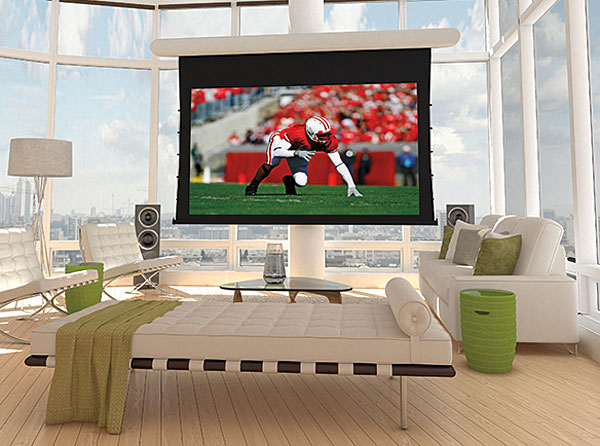 ,p.
A nose-to-screen comparison of the Phantom and FireHawk surfaces revealed a startling difference, despite the screens being more similar than not. The Phantom appeared textured, while the FireHawk—though somewhat speckled with a micro-metallic sheen—looked glass-smooth. Curious, I questioned whether the contouring on the Phantom’s surface—minute as it is—might create a shadowy texture to a certain object as it moved across the screen.
,p.
A nose-to-screen comparison of the Phantom and FireHawk surfaces revealed a startling difference, despite the screens being more similar than not. The Phantom appeared textured, while the FireHawk—though somewhat speckled with a micro-metallic sheen—looked glass-smooth. Curious, I questioned whether the contouring on the Phantom’s surface—minute as it is—might create a shadowy texture to a certain object as it moved across the screen.
To find out, I called up a test pattern on Murideo’s Fresco Six-G video pattern generator that I was certain would confirm what I was seeing. In this pattern, a white circle moves in a V from top right to middle bottom to top left against a black background, then traces back. Sure enough, the shadowy effect was clearly visible on the Phantom. For a useful analogy, call to mind any horror film that shows off the quintessential harvest moon pasted onto an inky night sky as the obligatory storm approaches. This was similar to the effect of those wind-wisped clouds passing before the orb in shadow form, caricature-like. I had made a vow to my editor to deliver a review free of sports references, but regrettably, I must break it: When I switched on the NHL playoffs, the camera pans pursuing the play against the static ice background distinctly dramatized this issue.
There was, perhaps, one more variable to pursue. The Phantom’s unveiling at CEDIA 2016 saw a larger version of the screen basking in 16,000 light-cannon lumens from a large-venue DPI projector. To the side, a 6,000-lumen DPI machine was pointed at a screen identical to my review sample. Did the Phantom simply favor or require more light output to avoid this odd anomaly?
Unsure whether the 2,500-lumen Epson PowerLite Home Cinema 3500 lacked sufficient horsepower and was contributing to the issue, I brought in heavy artillery: a 6,000lumen Epson Pro L1100U large-venue projector. When the pro unit’s lasers hit cruising speed, the Phantom admittedly took on a new persona. The white areas remained smudged as already described; however, the effect was somewhat diminished with nearly threefold lumens pummeling the screen.
Conclusions
There is one compelling reason why I can’t declare this mostly excellent screen a Top Pick: The puzzling artifact I’ve described prevents my full recommendation. This is not to imply that this screen should be overlooked for applications where its strong elements work best—quite the contrary. The Phantom is one of a wide variety of Stewart screen surfaces that exist as problem-solving tools. For situations where off-axis light striking the screen is anticipated and will possibly remain as a constant, the Phantom HALR provides an engineered option to effectively repel light. It is as capable with ambient light rejection as any competitive screen—and it’s superior, colorimetry-wise, to many. Ultimately, commercial applications may have the highest potential use for the Phantom, and deservedly so.
For residential use, however, we’ve discovered that some ALR screens can still be used in rooms devoid of light with superb results. So unless the Phantom is intended strictly for high ambient light environments, another Stewart ALR material somewhat more adept with darker rooms may be preferred. As always, custom integrators or consumers would be wise to carefully consider the type of content to be viewed, the screen size and projector output, and the variables of light conditions before making their choice.
- Log in or register to post comments

